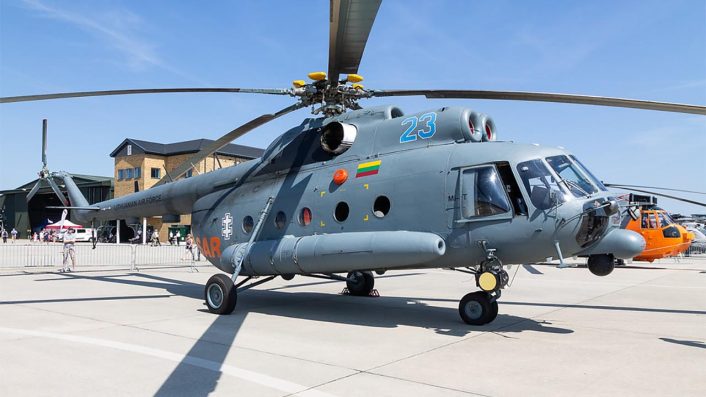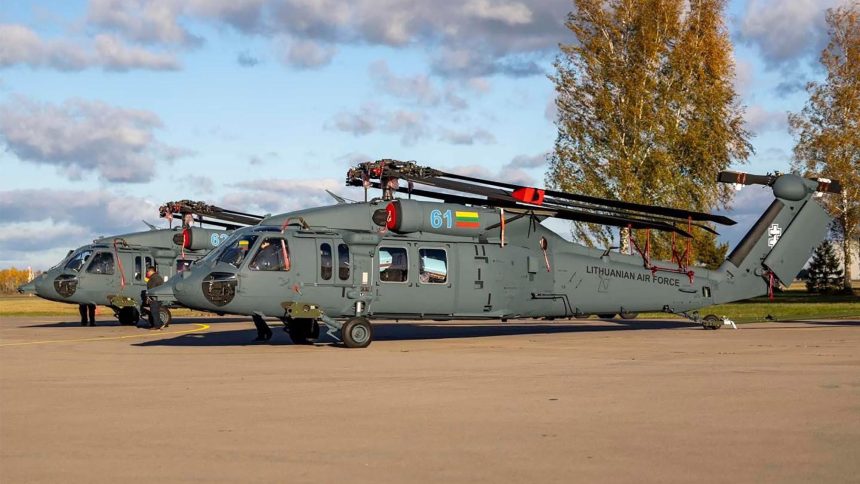The first two of four UH-60M Black Hawks ordered by the Lithuanian Air Force have been delivered following a $213 million order placed in 2020.
The Lithuanian Armed Forces released an image via social media on Oct. 19, 2025 showing off two of their new Sikorsky UH-60M Black Hawk helicopters for the first time. Four aircraft were ordered in 2020, with the option present for a further two airframes in the future.
Though the airframes were ready to undergo final configuration works by 2022, the initial expected delivery date of 2024 ended up slipping by a year due to an unspecified delay. First of type deliveries can be dependent on many underlying factors, requiring personnel to be trained from the ground up to operate and maintain the new aircraft and the installation of facilities to support them.
Our 🇱🇹Black Hawk. UH-60 Black Hawk helicopters that we purchased from the 🇺🇸US were recently delivered from @LockheedMartin to a modification factory in Huntsville, Alabama for further modernisation. By this acquisition, we are giving up our last Soviet relic – helicopters MI-8. pic.twitter.com/5xP56Buyvo
— Lithuanian MOD 🇱🇹 (@Lithuanian_MoD) August 16, 2022
Part of Lithuania’s overall effort to shift its military inventory away from Russian derived or built platforms – now effectively unable to receive manufacturer support, repairs, or upgrades – and towards equipment that is standardized with other NATO nations, the four Black Hawks will replace ageing Mil Mi-8 Hip transport helicopters. Lithuania has also recently ordered three C-390 Millennium transport aircraft from Embraer to operate alongside its fleet of C-27J Spartans, representing a significant increase in the nation’s air force inventory.

Marked as 61 Blue and 62 Blue, it is presumed the aircraft are U.S. serial numbers 21-27463 and 21-27464, which have previously been photographed prior to delivery and painting. The remaining two airframes are 21-27465 and 21-27466, likely to become 63 Blue and 64 Blue.
The Black Hawks will be based at Šiauliai Air Base, the Lithuanian Air Force’s central hub. Šiauliai has also hosted a number of NATO Baltic Air Policing deployments.
Bird in a cage: here are Lithuania’s first UH-60M helicopters. The first Black Hawks of the Lithuanian Armed Forces. The first Black Hawks bearing the Lithuanian flag and the Cross of Vytis. pic.twitter.com/RJn6oxjaFf
— Lithuanian_Armed_Forces (@LTU_Army) October 19, 2025
Lithuanian Defence Spending
Following the Russian invasion of Ukraine and increased pressures on NATO nations to contribute with defence spending, the Lithuanian government announced in March 2025 that it intends to increase defence spending to between five and six percent of the nations’s gross domestic product (GDP) between 2026 and 2030. While many procurement decisions stemming from this will still be in their early stages, it would likely include a significant investment in airborne capabilities.
First of all, the focus has been placed on the country’s ground forces. Joining 44 Leopard 2A8 main battle tanks ordered at the tail end of 2024 will, according to a letter of intent signed in June 2025, be a fleet of CV90 armoured vehicles. The decision was made in conjunction with simultaneous orders placed by Finland, Sweden, Norway, Estonia, and the Netherlands, with deliveries expected to commence in 2028.
Industry giants Northrop Grumman and Rheinmetall have both agreed memorandums of understanding (MoUs) with Lithuania with regards to ammunition manufacturing, and in the case of Rheinmetall committing to the construction of a new production plant within the country for 155 mm artillery ammunition. The need for a consistent, reliable and large scale supply of 155 mm shells, which are the standard size for NATO’s largest calibre artillery pieces, has been a particularly prudent requirement as Ukraine consistently reports an average consumption in excess of 5,000 shells per day. Not only must NATO absorb this usage, but its member states also need to produce enough for their own use and reserves.
New capabilities have also been added to existing platforms. Vilkas infantry fighting vehicles (IFVs), the local designation for the Boxer family, have now been equipped in Lithuanian service with the Spike LR2 anti-tank guided missile.
🇱🇹 Lithuania continues to modernise its armed forces – a new batch of Spike LR2 anti-tank missiles has been delivered.
Integrated into our Vilkas IFVs, they boost firepower and range, sending a clear signal of deterrence. pic.twitter.com/gnY4uo7hJz
— Lithuanian MOD 🇱🇹 (@Lithuanian_MoD) August 19, 2025
The Spike LR2 is one of the latest developments of Israel’s well regarded Spike missile family, in service from the early 1980s, which began operational deployment in the late 2010s. The missile boasts a range of up to 5.5 kilometres when fired from the ground, and has a warhead configurable for different blast effects depending on the type of target being engaged.
Baltic neighbour Latvia has also ramped up its investments in its armed forces, and received its first examples of the UH-60M in 2022 following an order placed in 2018. The operation of a common type between the two nations will likely benefit cooperation and joint training.
Stronger Latvian Air Force — stronger #NATO.
🎯 Today we opened the UH-60M Black Hawk helicopter aircrew flight training simulator in Lielvarde Air Base. This is an important step to further strengthen 🇱🇻 Air Force capabilities and pilot readiness.
We are grateful to the U.S.… pic.twitter.com/hw8sDNn6LS
— Andris Spruds (@AndrisSpruds) October 17, 2025
Notably, earlier this month, a U.S.-gifted UH-60M flight simulator was officially unveiled at Latvia’s Lielvarde Air Base. The potential for joint use of this facility would provide an important training aid for Lithuanian crew members without the need for unnecessarily replicating identical capabilities so close together, the funding for which could instead be directed elsewhere to provide another capability that will benefit both nations and the wider alliance.









